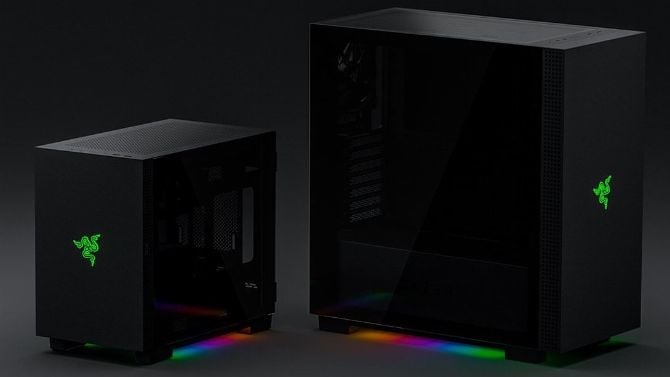Razer is an iconic PC video game brand specializing in gaming peripherals. However, unlike Corsair or Cooler Master, this has never been the case before. This is now being done with a range of two products, the Tomahawk ITX and the Tomahawk ATX. We tested the second model.
To the best of our knowledge, this is Razer’s first attempt in the PC box world. An attempt that he declines in two rounds: the Mini is intended for the Mini-ITX format, but its positioning is rather strange in that the tower still loads almost 6 kilograms on the scales. With its depth of 37 centimeters, it also takes up some space on the desktop: Razer did not want any restrictions on the graphics card. The same applies to the ATX version of the Tomahawk box that we are testing today.

A massive average tower!
Undoubtedly inspired by certain creations from Lian Li, Razer adopts a particularly sober design for this Tomahawk ATX. In the end, we can summarize this case as a large black block, which is rather imposing for an average tower measuring 49.5 x 23.5 x 47.5 cm. However, what we pay special attention to when leaving the box is the weight, which is well above the average for its category. At just over 13 kilograms on the scales, it pays the price for its design with a steel construction and removable tempered glass walls / hinges: once assembled, it’s clearly a model that we move as little as possible!
The Tomahawk ATX is completely black and only breaks that uniformity to incorporate three light zones. First, we find the brand’s logo – obviously green – on the front of the case. Second, we have two RGB strips under the case on the side edges. Razer’s obviously got the idea that its case should be quite high – placed on the desk, for example – so that the lighting on these RGB bands is clearly visible. In general, however, Razer delegates the imagination to other components, which is why tempered glass was used for the two side walls.
It’s about using the lights on the motherboard, graphics card, fans or cooling systems to make everything possible. To conclude the owner’s tour, we have to emphasize once again that the Tomahawk ATX has four fixed feet on the underside and that there is a dust filter on the power supply unit: it is easily removable so that it can be cleaned easily. On top of the case, Razer installed a second dust filter, which this time is magnetic: it is even easier to remove / clean, but it can tend to slip. One regret, Razer did not place filters on the front of the case.

Close to perfection
Remember that the facade is full, so a filter at this level would not have been helpful. On the other hand, ventilation takes place via grilles on the side parts of the facade. We’ll also have an opportunity to come back to this as it is the cause of one of the biggest flaws in this model. Once it’s the owner’s turn, it’s more than time to open the box to install our components. There’s nothing to be said about this opening: the tempered glass walls have a small button that you push to open them. They can then tilt on their hinges and stay in that position as you wish, or be completely removed for ease of assembly.
We chose this second solution and it must be recognized that we then have a large assembly room. Razer has succumbed to the fashion for the lower compartment for power and storage units: It is all the more efficient when another flap door opens to gain access to all these elements. Inserting the power supply unit (maximum depth 21 cm) is not a problem and the cables are fed through on the back of the motherboard. A cover is placed carefully so that it remains hidden as much as possible. There is also nothing to be said about the compatibility of the box, which allows practically all current PC configurations.
For example, we can switch from Mini-ITX format to E-ATX for the motherboard using anything that you are used to (Mini-DTX, Micro-ATX, ATX …). On the back of the motherboard, a clever cover covers the back plate of the CPU so that the heat sink cannot be changed too painfully if necessary. Note that the maximum height of the cooler is 176 mm, more than is required in principle. As a final restriction, it is possible to place even the most imposing models at the graphics card level without any problems: Razer has provided a gap of 384 mm. However, it is unfortunate that a graphics card storage system is not provided to ensure everything.
Despite the high price of its Tomahawk ATX, Razer decided to only include a single 120mm fan in its case. It is extracted at the rear. It is obviously possible to add: 3x 120 or 2x 140mm at the top of the box and 3x 120 or 2x 140mm in the front. Note, however, that these two series are designed for water cooling. Finally, let’s underline the presence of many slots for storage units, even if Razer – as is becoming more common – neither offers a 5.25-inch slot nor a slot to the outside: on the back there are 2 x 2.5-inch The card and there is a 3x 3.5-inch cage in front of the power supply unit.

Limit ventilation … think water cooling
Ultimately, it doesn’t take long to build a complete setup into the Tomahawk ATX. Everything is very well thought out, the arrangement of the elements is perfect, the surfaces flawless and everything is repaired smoothly. The knurled screws ensure a strong hold and the passage of the cables is a pleasure. The lighting of our Corsair Dominator memory strips and our Corsair iCUE H150i water cooling kit can be reproduced particularly well through the hardened glass pane … even if it’s all about taste. On the other hand, the severe lack of ventilation in this Razer case is all that is more objective and sadder.
Razer certainly intended it to use water cooling kits, and it’s true that the CPU has just gotten simpler. On the flip side, we feel that the manufacturer has given up on the graphics card problem: the single 12 cm fan in the extraction is insufficient to remove the hot air from the case, and temperatures rise rapidly. Without an additional fan, our Asus TUF Gaming RTX 3080 reached the ceiling with a load increase of over 89 ° C! Suffice it to say, we didn’t have the heart to test the thing for a long time. We quickly added three 12cm front fans and our water cooling kit was up.
The temperature was more reasonable then, but we were still slightly above 80 ° C under full load and then a second problem occurred: the air intake grilles on the side panels of the facade seem a little light to us to ensure their correct fit. Plus, as I said, they don’t have a built-in dust filter … which means the inside of the PC needs to be cleaned regularly. Fortunately, the doors open easily. The addition of three 12cm fans also resulted in a noticeable increase in noise nuisance, while the Tomahawk ATX was particularly gifted at this level … while having a single fan, it could be discreet!
| x | x | x | x | x |
| DE RSUM | ||||
|
A sleek, spacious case … and too expensive By discovering the Tomahawk ATXWe can only fall under the spell of its sober aesthetics, its exemplary finish and the materials used. Unfortunately, we quickly become disillusioned when we discover that the manufacturer left important questions unanswered, despite the high – even very high – costs of this solution. This leaves a lot of space for installation Water coolingRazer seems to be telling users to cool down in order to cool their setup: it only ships a single 12cm fan! While component installation is a model of this type, Razer didn’t pay much attention to airflow in its case: as a result, hot air becomes trapped there and the temperature inevitably rises. Elegant and solid, the Tomahawk ATX is therefore a case that we only knowingly recommend: you know that you will think about the subject of cooling well … more than 200 dollars, it is more than unfortunate. |
| x | x | x | xxxx | x | x | x |
| ON ONE GOAL: | We do not want: | |||||
|
|
| x | x | x | x | x |
| TECHNICAL WORKSHEET: | ||||
|
||||








